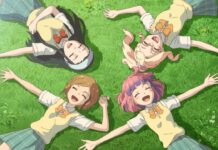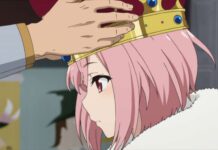An Aesthetic Ethnobiology
Ethnobiology is a sub-discipline of biology that focuses on knowledge of plants, animals, and cultures of an ethnic group. Ethnobiology is developed from ethnobotany and ethnozoology (Ford 2001 and Hunn 2007). Nowadays, ethnobiology can be stated as a study regarding human interactions with other organisms and social environment that are dependent of each other. It is strongly related to customs, myths, and cultures that have taken root in a given society. The purpose is to understand local knowledge to maintain the balance of nature and conserve the environment while rejuvenating the community’s existence in the area.

In Sakura Quest, the local knowledge of Manoyama had been inseparable with its people, yet the sentiment does not really being shared equally among its younger generation. For instance, Angelica’s daughter, Erika Suzuki, viewed Manoyama as a backwards region, comparing it with Harajuku even though the two places are obviously fundamentally different. However, her brother, Anji Suzuki, really loves Manoyama, and despite being younger than Erika, he has been contributing to preserving Manoyama’s local culture by being a taiko drummer in his school.
And then there is Ririko Oribe, the granddaughter of the Trade Representative of Manoyama. Before Yoshino came to Manoyama, she was a shut in (hikikomori) who could not socialize with others except her grandma. But, she has her own memories of Manoyama, from a local story of Manoyama her grandma always told her. Once upon a time, a dragon who lived in a mountain descended to Manoyama and blessed the region with fertility and a plentiful harvest. Yet, when the fall season arrived, the harvest decreased. People who became angry with the dragon burned it and sunk its body into the lake. For a period of time, the drought worsened, and people started to feel guilty to the dragon. The dragon has gone, leaving only its spirit haunting the people. The people then started to sing a song to resurrect the soul of the dragon. In the episode midway to the series, Ririko sang the song in a gathering night in Manoyama.
The song is an aesthetic creation that the people like, for it is something genuinely rooted in the identity of Manoyama people and not a fabricated identity. Manoyama’s branding through the kingdom of Chupakabura or even Kabuya (the previous name before Chupakabura) has actually failed because it lacks strong connections to the local culture of Manoyama, a foreign concept that has been forced into a community that does not understand it.

Yogyakarta, Bandung, Bogor, and several other regions in Indonesia have their own regional identities and they have become crucial assets to grow the potential of their cultures while maintaining them into the younger generations. This cannot be done just by putting them into the school’s curriculum, but they have to be part of the daily life of the society. For instance, Bogor Municipal Government has started “Rebo Nyunda” initiative, where all civil servants of Bogor Municipal Government are required to use Sundanese traditional clothes and speak Sundanese for the whole Wednesday, in order to preserve Sundanese culture in the society.
Conclusion
Manoyama is portrayed intriguingly with its complexities in this anime as Yoshino and her friends tries to participate in improving the region. The locals too, arre in need of major breakthrough to preserve the existence of Manoyama’s existence. The story Sakura Quest may feel slow-paced, but it’s actually condusive to learn more about the anthropology of Manoyama people in general, as well as thinking about how a rural region can be developed without abandoning the ethnobiology of the region, as aspects that really matter and to the local people.
The Indonesian Anime Times | Translated by Zacky Dhaffa Pratama | Originally written by R Ikhsan Nur Akbar from KAORI Newsline





